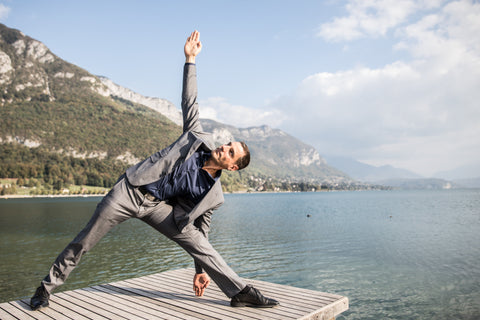Portrait of a surfer yogini with misaligned chakras; Laura
What immediately appealed to me about Laura Cabeza is that, like me, Laura is passionate about surfing and yoga. She practices Yoga in the South of France, in Paris and in Bali. Her universe; sometimes cosmic, sometimes comical, sometimes both, is full of freshness and humility. Creator of the blog " Oh My Buddha" , always on the move, passionate about travel, Yoga, surfing and holistic medicine, Laura fully discovered herself by traveling the globe in search of new teaching methods. Today, she transmits her passions through her new project "AlohaYoga" . She organizes, in the wonderful island of Bali, initiatory stays "good vibes only", "energetic healing", in small groups and in full awareness in magical and exotic places.
It was only natural that I asked him a few personal questions about his yoga practice, which I am sharing with you today.
How did you get into taking care of yourself?
I understood that when it came to having fun, I was often the queen of extremes! One day, my body said stop… I had always known that the time would come when I would get serious about Yoga. So it was after injuring my shoulder during a boxing session - I wasn't very zen in the past... - that I made the decision that changed my life.
What practice for your well-being?
I have always had major back problems - and sitting during my three years of journalism did nothing to help. It is therefore essential for me to start the day with a little routine of stretching and postures aimed at decompressing my lower back. Then I meditate, then I go surfing - ideal for building muscle after creating space in my body. After that, I finally have a great breakfast. I also regularly need to create, this can be through writing but also drawing or a great Yoga flow that takes me completely unexpectedly in the middle of my living room... Sometimes I stay in bed and do nothing, that's also very good :)
What is the ritual of your practice?
I try to always be clear with my intentions but also to show gratitude in order to be as positive as possible and to manifest the best. For example, when I have a lot of back pain, I ask to be guided on the path to appeasement, and rather than blaming the Universe, myself or others for being in this state, I thank the opportunities that this represents: those of being better connected to my body and my intuition, or even of being a better teacher for those who suffer in the same way. It took me time to understand all this, and it is not always easy but it really makes a difference on a daily basis.
What do you get out of it?
More wisdom and lucidity in what I undertake. A better relationship with myself, my body, my surroundings and the Universe. What I need and want manifests naturally, almost effortlessly.
What do you carry in your yoga bag?
What to change into afterwards because where I live it's over 30 degrees and it's clearly unthinkable to stay in leggings after sweating ;)
What is your favorite object/accessory?
If there is one quality that I can recognize in myself, it is that I have no attachment to equipment! Including Yoga, I love practicing without a mat, just in contact with the ground… However, I need a good support to sit and meditate. And I am crazy about my surfboard, just looking at it makes me totally vibrate!
What would be your advice for Tayrona Yoginis?
What I learned while walking with Yoga and meditation is honesty: for example, I no longer care today about what my practice looks like from the outside, all that matters is: does it make me feel good inside? Why do I go so far in this posture? Is it out of ego or real necessity?
Also, never take yourself too seriously, if something no longer brings you joy, spontaneity and humility: run away!
Where/how do you practice?
I practice at home and in the places I choose to host Aloha Yoga retreats, always in contact with nature and the very particular energies of Bali.



























